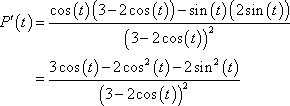MATHS :: Lecture 05 :: Differential Calculus(1)
![]()
DIFFERENTIATION
In all practical situations we come across a number of variables. The variable is one which takes different values, whereas a constant takes a fixed value.
Let x be the independent variable. That means x can take any value. Let y be a variable depending on the value of x. Then y is called the dependent variable. Then y is said to be a function of x and it is denoted by y = f(x)
For example if x denotes the time and y denotes the plant growth, then we know that the plant growth depends upon time. In that case, the function y=f(x) represents the growth function. The rate of change of y with respect to x is denoted by ![]() and called as the derivative of function y with respect to x.
and called as the derivative of function y with respect to x.
S.No. |
Form of Functions |
y=f(x) |
|
1. |
Power Formula |
xn |
|
2. |
Constant |
C |
0 |
3. |
Constant with variable |
Cy |
|
4. |
Exponential |
ex |
ex |
5. |
Constant power x |
ax |
ax log a |
6. |
Logirthamic |
logx |
|
7. |
Differentiation of a sum |
y = u + v |
|
8. |
Differentiation of a difference |
y = u – v |
|
9. |
Product rule of differentiation |
y = uv, |
|
10. |
Quotient rule of differentiation |
y = |
|
Example
- Differentiate each of the following function




Solution
![]()
- Differentiate following function




Solution
Here is the derivative.
![]()
![]()
![]()
![]()
- Differentiate following function




Solution
![]()
![]()
![]()
![]()
diff. w.r.to x
![]()
![]()
![]()
![]()
MPSetEqnAttrs('eq0008','',3,[[90,34,13,-1,-1],[118,46,17,-1,-1],[148,57,21,-1,-1],[],[],[],[372,141,53,-3,-3]]);
ExampleBegin(); 4. Differentiate the following functions.
a) ![]()
![]()
Solution
MPSetEqnAttrs('eq0009','',3,[[84,18,5,-1,-1],[111,24,7,-1,-1],[139,31,8,-1,-1],[],[],[],[348,77,21,-3,-3]]) MPEquation() ![]()
![]()
![]()
![]()
MPSetEqnAttrs('eq0011','',3,[[76,23,5,-1,-1],[101,32,7,-1,-1],[127,40,8,-1,-1],[],[],[],[315,98,22,-3,-3]]) MPEquation() ![]()
![]()
![]()
![]()
diff y w. r. to x MPSetEqnAttrs('eq0012','',3,[[154,27,9,-1,-1],[205,38,13,-1,-1],[257,47,16,-1,-1],[],[],[],[641,114,39,-3,-3]]) MPEquation() ![]()
![]()
![]()
![]()
MPSetEqnAttrs('eq0012','',3,[[154,27,9,-1,-1],[205,38,13,-1,-1],[257,47,16,-1,-1],[],[],[],[641,114,39,-3,-3]]); MPSetEqnAttrs('eq0013','',3,[[132,62,28,-1,-1],[175,83,37,-1,-1],[218,105,47,-1,-1],[],[],[],[547,258,117,-3,-3]]);
ExampleBegin(); 5. Differentiate the following functions. MPSetEqnAttrs('eq0014','',3,[[218,34,14,-1,-1],[289,45,19,-1,-1],[361,55,23,-1,-1],[],[],[],[905,141,58,-3,-3]]) MPEquation() MPSetEqnAttrs('eq0009','',3,[[84,18,5,-1,-1],[111,24,7,-1,-1],[139,31,8,-1,-1],[],[],[],[348,77,21,-3,-3]]); ![]()
![]()
![]()
![]()
MPSetEqnAttrs('eq0010','',3,[[130,17,6,-1,-1],[172,22,7,-1,-1],[216,27,8,-1,-1],[],[],[],[539,71,22,-3,-3]]) MPEquation() ![]()
![]()
![]()
![]()
![]()
diff f(x) w r to x
![]()
![]()
![]()
![]()
Derivatives of the six trigonometric functions

![]()
![]()
![]()
Example
1. Differentiate each of the following functions.
![]()
![]()
![]()
![]()
Solution We’ll just differentiate each term using the formulas from above.
![]()
![]()
![]()
![]()
2. Differentiate each of the following functions ![]()
![]()
![]()
![]()
Here’s the derivative of this function.
![]()
![]()
![]()
![]()
Note that in the simplification step we took advantage of the fact that
![]()
![]()
![]()
![]()
![]()
to simplify the second term a little.
3. Differentiate each of the following functions ![]()
![]()
![]()
![]()
In this part we’ll need to use the quotient rule.

![]()
![]()
![]()
| Download this lecture as PDF here |
![]()